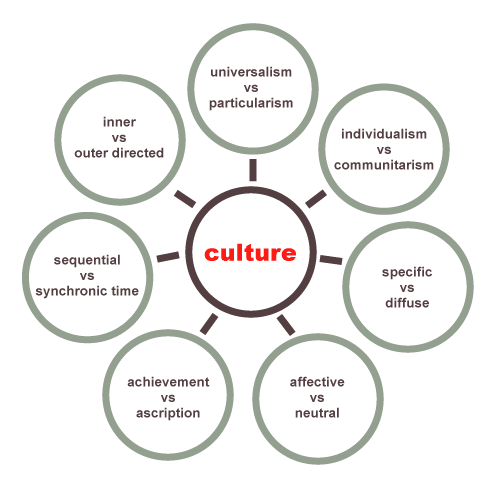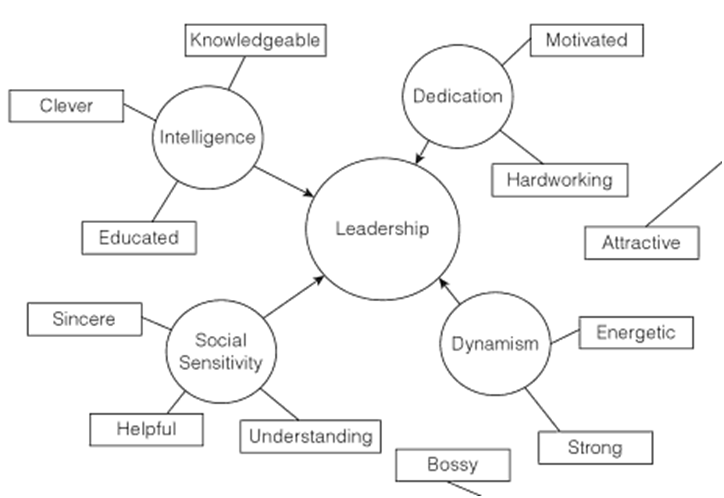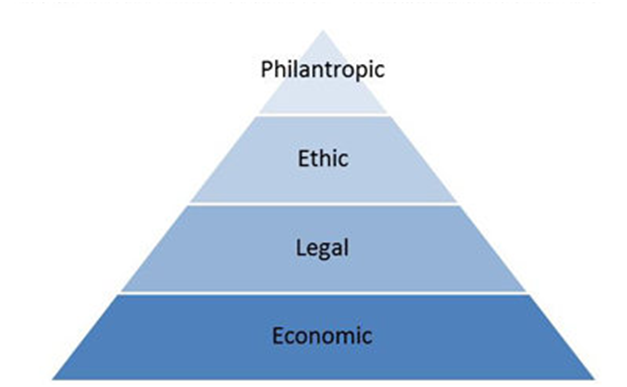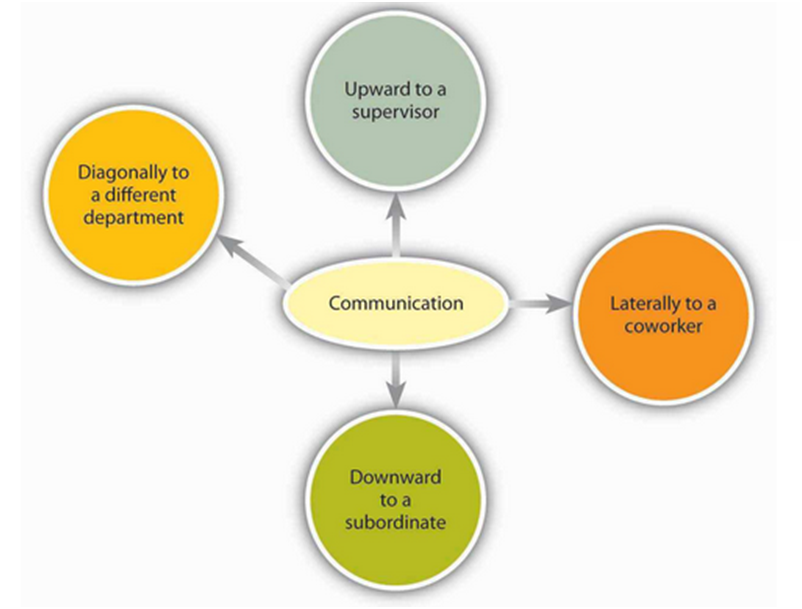
Trompenaars and Hampden-Turner Cultural Dimensions consists of universalism versus particularism, individualism versus collectivism, achievement versus ascription, neutral versus affective, specific versus diffuse, internal versus external, and time orientation. Universalism versus particularism relates to the extent of importance of formal rules and procedures over circumstances and relationships. Universalistic cultures rely on formal rules and regulations to govern various aspects of life, whereas members of particularistic cultures tend act according to circumstances. Bhattacharyya (2010) links this specific cultural dimension to the levels of paperwork and bureaucracy in organisations. According to Bhattacharyya (2010), the levels of organisational bureaucracy are usually greater in organisations with universalistic cultures compared to particularistic organisations. Individualism versus collectivism is similar to relevant cultural dimension proposed by Hofstede as discussed above. In individualistic cultures interests of individuals usually prevail over the interest of the group, whereas in collectivistic organisations the whole teams, rather than individuals are credited with organisational successes, as well as, failures. Achievement versus ascription marks the level of tolerance of society towards the pattern of distribution of power and status amongst members of society. This cultural dimension is quite similar to power distance cultural dimension presented by Geert Hofstede. In societies and organisations with achievement-oriented cultures power, status and other befits are provided for individuals that are high achievers. In ascription-oriented organisations, on the other hand, power and management positions are given on the basis of family backgrounds, age, gender and others. Moran et al. (2011), Maude (2011) and a range of other authors present convincing arguments about the advantages of achievement-oriented organisational cultures over ascription-oriented organisations in terms of increasing the level of effectiveness in achieving organisational objectives. Specifically, employees in achievement-oriented organisations are found to be better motivated to contribute to the achievement of organisational objectives compared to employees in ascription-oriented organisations. Neutral versus affective…

The literature review has identified the main differences between private and public sector organisations to relate to organisational aims and objectives, organisational stakeholders and stakeholder expectations, the levels of public scrutiny, external environment and its impacts and sources of motivation for employees. 1. Differences in Organisational Aims and Objectives According to Kassel (2010), Chaston (2011) and others, organisational aims and objectives represent the main point for difference between public and private sector organisations. The main objective for the majority of private sector organisations relates to maximising financial returns for investors, whereas the majority of organisations in public sector have been found to pursue objectives other than profit maximisation, such as providing various services and products for the public (Kassel, 2010, Chaston, 2011). The level of clarity of organisational objectives has emerged as an additional difference between public and private sector organisations. Specifically, according to Wright et al. (2012), while the main or even only objective for private sector organisations – maximising profits is straightforward, and therefore clearly understood by employees at all levels, the perceptions of goal clarity amongst public sector employees tends to be lower. 2. Stakeholders in Public Sector and Private Sector Organisations and Their Expectations The type of stakeholders and stakeholders’ expectations has emerged as another point of stark difference between private and public sector organisations (Chaston, 2011). Stakeholders can be defined as “any party or group who is able to influence (affect) or be influenced (affected) by the organisation and its activities” (Brink and Berndt, 2009, p.156). Stakeholders can be divided into two categories: internal and external (Parhizgari and Gilbert, 2004, Crosby and Bryson, 2005). Internal organisational stakeholders have direct relationship with an organisation and they are directly impacted by performance of the organisation. External stakeholders, on the other hand, may not be impacted…

Reasonable amount of works have been devoted to the study of leadership skills and capabilities. According to Bertocci and Bertocci (2009), one of the most basic and necessary leadership qualities relates to the development of organisational vision in an effective manner and ensuring that employees are motivated by this vision. Ricketts and Ricketts (2011) consider the ability to influence others as a core leadership quality. At the same time, Ricketts and Ricketts (2011) accept that influencing can be done in a positive or negative manner and discusse the advantages of positive influencing as compared to negative influencing in long-term perspective. Similarly, the ability to motivate other people is seen by Davies and Brundrett (2010) as one of the most important trait for leaders. Confirming this point, Obolensky (2010) finds positive correlation between the level of effectiveness of organisational leaders, and the use of intangible motivational tools. In other words, according to Obolensky (2010) the most effective leaders use tangible motivational tools to a minimum extent, effectively appealing to inner psychological and career development needs of their subordinates. Differences between tangible and intangible motivators and their implications on leadership practices need to be explained in greater detail in order to further clarify the point above. Schermerhorn et al. (2011) confirm that tangible motivational tools include elements present in physical terms that can be obtained and/or experienced such as money, holidays, free meal, etc. Intangible motivational tools, on the other hand, include prestige, verbal and written appreciations from management, the provision of various titles etc (Griffin, 2011). Forsyth (2009) covers a greater range of leadership skills and capabilities in his work and represents interrelationships within leadership skills and capabilities in the following manner: Important leadership skills and capabilities Source: Forsyth (2009) Specifically, leadership skills and competencies are divided by Forsyth (2009) into…

Leadership styles are generally divided into four categories: autocratic, consultative, democratic, and laissez-faire (Daiels, 2004, Davies and Brundrett, 2010). The following table contains the description of each style, relevant leader behaviours and potential impact on employees: Style Description Leader behaviours Potential impact on employees Autocratic Basic premise: leader knows best. Communication flows downwards Controlling Directive Makes all decisions and solves all problems Issues commands Hostility Rebellion Consultative Basic premise: leader informs members of best concepts Directive approach; teacher of information Increases knowledge levels Democratic (Participative) Basic premise: every member should have input. Communication is open and mutual Acts as a facilitator. Serves as a resource person Encourages members’ active participation Improved productivity More opportunity for personal growth Increased cooperation and teamwork Laissez-Faire Leadership responsibilities are assumed by group. Almost any behaviour by group is permissible due to the leader’s lack of limit-setting and stated expectations Passive, non-directive approach. Provides little, if any support, guidance, or feedback. Sets no limits Unmet tasks Relationship needs of group members ignored Apathy Descriptions of leadership styles, leader behaviours, and potential impact on employees Source: Daniels (2004) The majority of authors stress the advantages of democratic leadership style over autocratic leadership at various levels. Interestingly, Dukakis et al. (2010) argue that the negative impacts of autocratic leadership are starkly evident in private sector organisations compared to public sector organisations. To explain this point, Dukakis et al. (2010) reason that leadership issues in private sector organisations associated with the application of autocratic leadership style would be reflected in the level of revenues, whereas leadership ineffectiveness in public sector organisations might be tolerated for longer periods of time. Davies and Brundrett (2010) warn not to dismiss autocratic leadership style as totally inappropriate referring to specific cases where autocratic leadership might prove to be effective. Davies and Brundrett…

The concept of CSR Pyramid, proposed by Carroll (1983) divides business obligations into four levels, explaining requirements of obligations in each level, as well as their importance. Economic responsibility is considered to be core responsibility of the business and it relates to profit maximisation. Economic responsibility is mainly self-regulatory in a way that if a business entity neglects or fails to meet its economic responsibilities it is just a matter of time before the business becomes a history. Legal responsibility of a firm relates to adhering to rules and regulations of the respective government. Meeting legal responsibilities is critically important for businesses and the case study of Enron can be mentioned to explain the potential negative consequences of abusing legal responsibilities. Ethical responsibilities for a business entity relate to certain responsibilities that go beyond basic economic and legal requirements for a business entity. Ethical responsibilities are usually expected by organizational stakeholders, but usually there are no government laws and regulations to enforce these responsibilities. However, each case is different and there might be instances where governments may interfere in relation to ethical issues. Philanthropic responsibility is understandably placed at the highest level of responsibilities because it is not generally expected and mainly initiated for advertisement and public relations purposes. Philanthropic acts engaged by businesses may include sizable donations to various causes or local communities, or contributing to society in other ways. Although Carroll’s CSR Pyramid is widely considered to be a substantial contribution to the development of the field of CSR, it has been criticized by various authors. Hockerts et al. (2008) criticise this framework by arguing that there is no need to represent CSR as a hierarchy. In other words, according to Hockerts et al. (2008), unlike Maslow’s Hierarchy of Needs, in Carroll’s CSR Pyramid there are weak or…

According to Horrigan (2010) there is no widespread definition of CSR due to the high levels of ambiguity and controversy associated with the topic. It has to be noted that “virtually all definitions of CSR include the notion that business firms (i.e., corporations) have obligations toward society beyond their economic obligations to shareholders” (Schwartz, 2011, p.19) Nevertheless, CSR definition that captures the main aspects of the term can be proposed as “corporate initiative to assess and take responsibility for the company’s effects on the environment and impact on social welfare” (Investopedia, 2013, online). Additionally, the following definitions of CSR have been proposed by different authors: “how companies manage the business processes to produce an overall positive impact on society” (Baker, 2004) “continuing commitment by business to behave ethically and contribute to economic development while improving the quality of life of the workforce and their families, as well as of the local community and society at large” (World Business Council for Sustainable Development in Hopkins, 2007) additional responsibilities of businesses to local and wider communities apart from its core responsibility of profit maximisation (Simpson and Taylor, 2013) References Baker, M. (2004) “Corporate Social Responsibility – What does it mean?” Available at: http://www.mallenbaker.net/csr/definition.php Corporate Social Responsibility (2013) Investopedia, Available at: http://www.investopedia.com/terms/c/corp-social-responsibility.asp#axzz2A54oj5IY Horrigan., B. (2010) Corporate Social Responsibility in the 21st Century: Debates, Models and Practices Across Government, Law and Business, Edward Elgar Publishing, Cheltenham, UK Schwartz, M.S. (2011) “Corporate Social Responsibility: An Ethical Approach” Broadview Press, USA Simpson, J. & Taylor, J.R. (2013) “Corporate Governance Ethics and CSR” Kogan Page
October 29, 2013
By John Dudovskiy
Category: Corporate Social Responsibility
Tags: Definitions, Ethics

There is a set of factors that could have negative implications in facilitation of organisational communication. These barriers include choice of the wrong communication medium, incorrect use of language, wrong type of message, inappropriate appearance of message, use of jargon, emotional barriers, and physical disabilities. 1. Choice of Wrong Communication Medium The choice of wrong communication medium is one of the most common communication barriers. The choice of communication medium need to correspond to the nature of the message. For example, giving negative feedback regarding any aspect of employee performance is better done through a verbal communication in a constructive way, rather than sending a letter or an e-mail. 2. Incorrect Use of Language Incorrect use of language can also be specified as one of the major barriers to effective communication and this may relate to grammar, punctuation, spelling and a range of other issues. 3. Wrong Type of Message Another significant barrier to communication may relate to inappropriate choice of the type of message. Complex instructions to employees need to be communication in written forms, whereas interpersonal and other conflicts are best resolved with oral communication. 4. Inappropriate Appearance of Message Ineffective appearance of the message can also prove to be a communication barrier in organisational settings. Inappropriate appearance of the message is usually caused by its poor expression associated with readability, light print, omissions, ineffective sentence structure and others. Ineffective organisation of ideas and poor choice of words in verbal communication can be specified as additional reasons of inappropriate message appearance. 5. Use of Jargon A range of occasions and reasons when jargons are used may relate to communicating with individuals within the same industry, unthinking use of jargons, attempts to impress the receiver(s) of message, altering the attention of receiver from…

Increasing importance of communication in organisations has been discussed by a number of authors, the most notably in the works of Mangion (2011), Guffey and Loewy (2012), Zeng (2012) and DeVito (2012). Mangion (2011) detects a direct link between the quality of management-employee communication and the level of achievement of organisational aims and objectives. Moreover, Mangion (2011) convincingly argues that increasing importance of communication in organisations is linked to shortening period of time associated with decision making. The level of communication in organisations between management and employees also has implications on the level of trust of employees towards management (Guffey and Loewy, 2012, Zeng, 2012). According to the findings of Guffey and Loewy (2012), in organisations where management regularly communicates with workforce employees tend to have greater level of trust and confidence, and consequently loyalty to their management. Similarly, DeVito (2012) finds positive correlation between the qualities of management-employee communication and the level of employee motivation. DeVito (2012) explains this finding in a way that a high quality of management-employee communication creates the feeling of involvement in organisational decision making in employees, and thus they become more empowered to perform their duties. Moreover, DeVito (2012) argues that communication in organisations might have several directions and illustrates these directions as it is represented below Directions of Organisational Communication Source: DeVito (2012) The most popular communication methods in organisations include e-mails, face-to-face meetings, group shifts meetings, scheduled and unscheduled meetings and others (Yates, 2007, Innis and Watson, 2008, Zeng, 2012). Hargie (2012) links the increasing importance of communication in healthcare organisations in particular to regular technological innovations and technological breakthroughs within the same sector. Moreover, important attributes of private healthcare organisations have been specified by Guffey and Loewy (2012) and Zeng (2012) as increased level of power of external stakeholders, high level…

Channels of communication can be divided into four categories: nuturative, requisitive, directive, and emotive. Moreover, employees can also be divided into reactor, workaholic, persister, dreamer, rebel, and promoter categories. Pauley and Pauley (2009) correspond the utilisation of each of these channels to the types of employees in the following manner: Type Channel Reactor Nuturative Workaholic Requestive Persister Requestive Dreamer Directive Rebel Emotive Promoter Directive Source: Pauley and Pauley (2009) References Pauley, J.A. & Pauley D.J. (2009) “Communication: The Key to Effective Leadership” ASQ Quality Press

Verbal Communication Verbal communication is facilitated with the use of voice and words. Generally, the key elements of verbal communication include words, sound, languages, and the physical act of speaking. The majority of verbal communication account for casual exchanges with other people. In verbal communication there is a clear and personal communication link between senders and receivers. Challenges associated with verbal communication include poor choice of wording, physical disabilities, ineffective utilisation of communication techniques, and subjective opinions. The outcomes of verbal communication between managers and subordinates can be compromised in terms of achieving its objectives through the negative impact of certain factors. These factors include poor listening skills of managers, emotional barriers, use of inappropriate language. Non-verbal Communication The majority of communication is facilitated in non-verbal ways. Non-verbal communication can be divided into the following eight categories: facial expression, appearance, haptics, gestures, eye gaze, paralinguistics, proxemics, and body language and posture. One of the main differences of non-verbal communication from verbal communication can be specified in a way that in former form the communication can be done intentionally, as well as, unintentionally. In other words, when an individual is experiencing specific feelings such as boredom, excitement, or fear, his or her feelings can be communicated through non-verbal channels even when the individual does not aim to communicate them intentionally.
